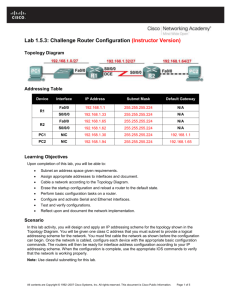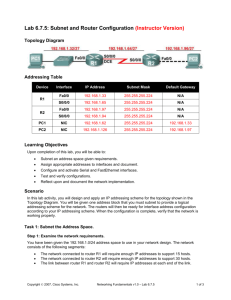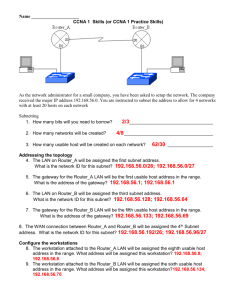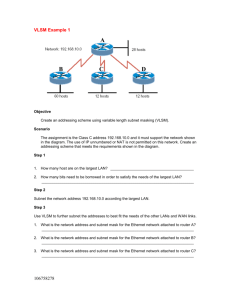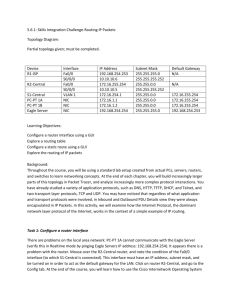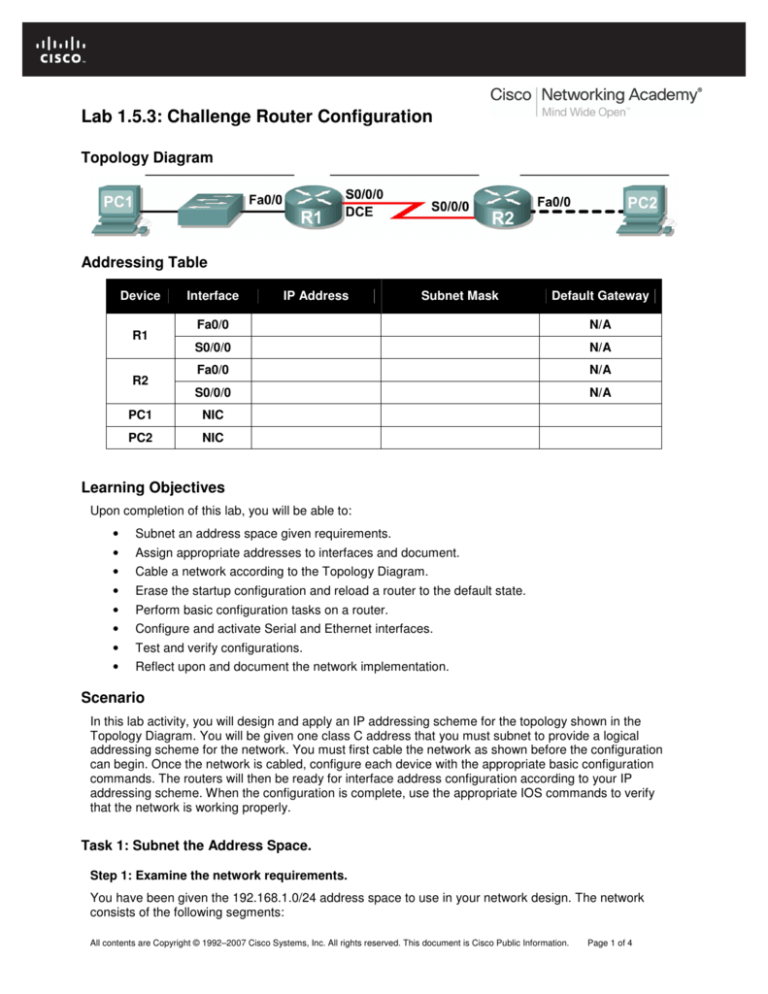
Lab 1.5.3: Challenge Router Configuration
Topology Diagram
Addressing Table
Device
R1
R2
Interface
IP Address
Subnet Mask
Default Gateway
Fa0/0
N/A
S0/0/0
N/A
Fa0/0
N/A
S0/0/0
N/A
PC1
NIC
PC2
NIC
Learning Objectives
Upon completion of this lab, you will be able to:
•
Subnet an address space given requirements.
•
Assign appropriate addresses to interfaces and document.
•
Cable a network according to the Topology Diagram.
•
Erase the startup configuration and reload a router to the default state.
•
Perform basic configuration tasks on a router.
•
Configure and activate Serial and Ethernet interfaces.
•
Test and verify configurations.
•
Reflect upon and document the network implementation.
Scenario
In this lab activity, you will design and apply an IP addressing scheme for the topology shown in the
Topology Diagram. You will be given one class C address that you must subnet to provide a logical
addressing scheme for the network. You must first cable the network as shown before the configuration
can begin. Once the network is cabled, configure each device with the appropriate basic configuration
commands. The routers will then be ready for interface address configuration according to your IP
addressing scheme. When the configuration is complete, use the appropriate IOS commands to verify
that the network is working properly.
Task 1: Subnet the Address Space.
Step 1: Examine the network requirements.
You have been given the 192.168.1.0/24 address space to use in your network design. The network
consists of the following segments:
All contents are Copyright © 1992–2007 Cisco Systems, Inc. All rights reserved. This document is Cisco Public Information.
Page 1 of 4
CCNA Exploration
Routing Protocols and Concepts:
Introduction to Routing and Packet Forwarding
•
•
•
Lab 1.5.3: Challenge Router Configuration
The network connected to router R1 will require enough IP addresses to support 20 hosts.
The network connected to router R2 will require enough IP addresses to support 20 hosts.
The link between router R1 and router R2 will require IP addresses at each end of the link.
Step 2: Consider the following questions when creating your network design.
How many subnets are needed for this network? ____________________
What is the subnet mask for this network in dotted decimal format? ____________________
What is the subnet mask for the network in slash format? ____________________
How many usable hosts are there per subnet? ____________________
Step 3: Assign subnetwork addresses to the Topology Diagram.
1. Assign subnet 1 to the network attached to R1.
2. Assign subnet 2 to the link between R1 and R2.
3. Assign subnet 3 to the network attached to R2.
Task 2: Determine Interface Addresses.
Step 1: Assign appropriate addresses to the device interfaces.
1. Assign the first valid host address in subnet 1 to the LAN interface on R1.
2. Assign the last valid host address in subnet 1 to PC1.
3. Assign the first valid host address in subnet 2 to the WAN interface on R1.
4. Assign the last valid host address in subnet 2 to the WAN interface on R2.
5. Assign the first valid host address in subnet 3 to the LAN interface of R2.
6. Assign the last valid host address in subnet 3 to PC2.
Step 2: Document the addresses to be used in the table provided under the Topology Diagram.
Task 3: Prepare the Network
Step 1: Cable a network that is similar to the one in the Topology Diagram.
You can use any current router in your lab as long as it has the required interfaces as shown in the
topology.
Step 2: Clear any existing configurations on the routers.
All contents are Copyright © 1992–2007 Cisco Systems, Inc. All rights reserved. This document is Cisco Public Information.
Page 2 of 4
CCNA Exploration
Routing Protocols and Concepts:
Introduction to Routing and Packet Forwarding
Lab 1.5.3: Challenge Router Configuration
Task 4: Perform Basic Router Configurations.
Perform basic configuration of the R1 and R2 routers according to the following guidelines:
1. Configure the router hostname.
2. Disable DNS lookup.
3. Configure an EXEC mode password.
4. Configure a message-of-the-day banner.
5. Configure a password for console connections.
6. Configure a password for VTY connections.
Task 5: Configure and Activate Serial and Ethernet Addresses.
Step 1: Configure the router interfaces.
Configure the interfaces on the R1 and R2 routers with the IP addresses from your network design. When
you have finished, be sure to save the running configuration to the NVRAM of the router.
Step 2: Configure the PC interfaces.
Configure the Ethernet interfaces of PC1 and PC2 with the IP addresses and default gateways from your
network design.
Task 6: Verify the Configurations.
Answer the following questions to verify that the network is operating as expected.
From the host attached to R1, is it possible to ping the default gateway? __________
From the host attached to R2, is it possible to ping the default gateway? __________
From the router R1, is it possible to ping the Serial 0/0/0 interface of R2? __________
From the router R2, is it possible to ping the Serial 0/0/0 interface of R1? __________
The answer to the above questions should be yes. If any of the above pings failed, check your physical
connections and configurations. If necessary, refer to Lab 1.5.2, “Basic Router Configuration.”
What is the status of the FastEthernet 0/0 interface of R1? _____________
What is the status of the Serial 0/0/0 interface of R1? _____________
What is the status of the FastEthernet 0/0 interface of R2? _____________
What is the status of the Serial 0/0/0 interface of R2? _____________
All contents are Copyright © 1992–2007 Cisco Systems, Inc. All rights reserved. This document is Cisco Public Information.
Page 3 of 4
CCNA Exploration
Routing Protocols and Concepts:
Introduction to Routing and Packet Forwarding
Lab 1.5.3: Challenge Router Configuration
What routes are present in the routing table of R1?
__________________________________________________________________________
__________________________________________________________________________
What routes are present in the routing table of R2?
__________________________________________________________________________
__________________________________________________________________________
Task 7: Reflection
Are there any devices on the network that cannot ping each other?
__________________________________________________________________________
__________________________________________________________________________
What is missing from the network that is preventing communication between these devices?
__________________________________________________________________________
__________________________________________________________________________
Task 8: Document the Router Configurations.
On each router, capture the following command output to a text (.txt) file and save for future reference.
•
Running configuration
•
Routing table
•
Summary of status information for each interface
All contents are Copyright © 1992–2007 Cisco Systems, Inc. All rights reserved. This document is Cisco Public Information.
Page 4 of 4



